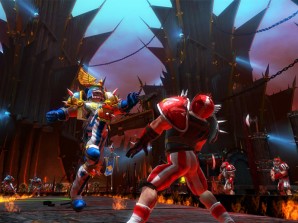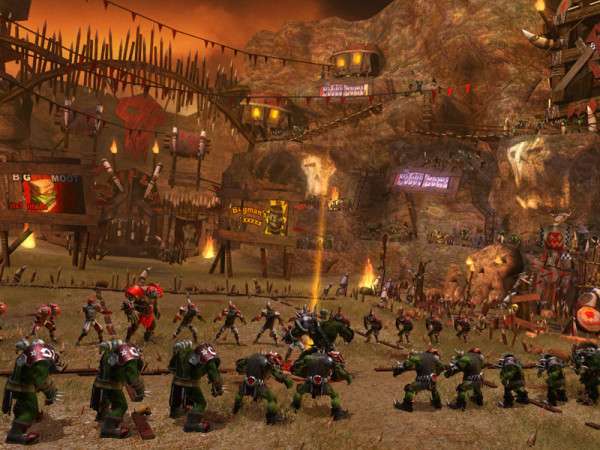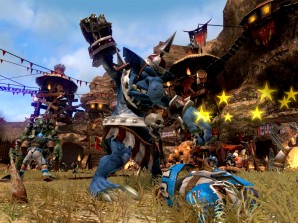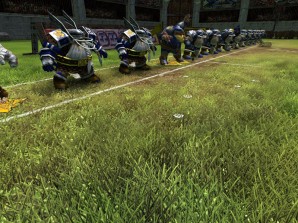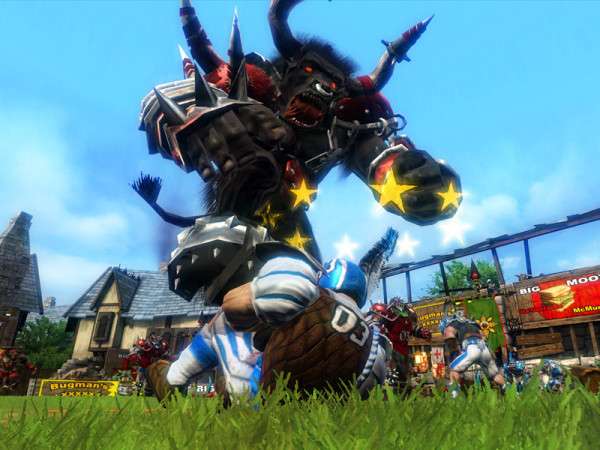Blood Bowl PC, PSP, DS Review

To understand the concept of Blood Bowl the video game, you need to look back to 1987 when Games Workshop released the dice-based board game of the same name. It took America’s favourite sporting event, American Football and turned up the brutality to eleven while mixing in Games Workshop’s races from games like Warhammer. Everyone’s favourites are included with the likes of Humans, Orcs, Dwarfs, Wood Elves, Goblins, Lizardmen, Chaos and Skaven.
Most often than not, when a board game gets turned into a video game, they usually don’t turn out quite as well as one would hoped for. The team at Cyanide are hoping to change all of that, and you know what? For the most part it works. Please note: this review focuses on the PC version, there’s a separate section at the end to directly address the PSP and DS releases.
Each race has their own team, and as a result have strengths and weaknesses. For example, the Orcs have excellent strength and armour ratings, but are clumsy. Goblins on the other hand are agile and great at cheating, but because they are so brittle, they get injured easily. It’s best to select a team that suits how you want to play – doing so will give you more of an advantage when it comes to the dice rolling.
Jumping straight into a game of Blood Bowl is not recommended, especially for people who haven’t even played the board game before. To make matters worse, the tutorial doesn’t best explain how to play. It tells you some of the features, but doesn’t always go into the depth you would like. Instead, the game asks you to read the manual if you want any more help in playing the game and understanding the rules.
Once you’ve got down the idea of the game (some quick plays are recommended first) you’ll want to jump into the campaign mode. This features two distinctive gameplay options: Classic and Blitz. Classic is a direct one-for-one adaption of the board game. Blitz on the other hand opens up plenty of customisation for the player, adding features to the traditional rules. Things like allowing you to change the game into realtime (more on that later), salaries, contracts, player aging, and purchasing additional equipment.
Since the realtime mode is only available in Blitz, you’ll have to select that mode to play it, but in fact I don’t think anyone will play in realtime, only maybe to experience it and realise that the game just doesn’t play out as well. Realtime doesn’t mean it turns into Mutant League Football or Madden, with you physically controlling a player. Instead, it just means that it gets rid of the stop-start of turn-based mode. The controlling of the characters is the same, so you’ve got to click on them with the mouse and tell them where to move around the pitch – you have to do that individually for each team member. It does give you the ability to give your players AI commands, but the dice rolling is still going on in the background as you move around. Realtime translates into a total mess, and by getting rid of the strategic aspect to the game it destroys what Blood Bowl is all about. The realtime feature isn’t even in the PSP and DS versions of the game, so why bother with having it in the PC one?
Now that we’ve got over the point of how realtime isn’t any good, you’ll want to understand how the turn-based mode works. At the start of the match you’ll be given an option to select your formation. This is just to say where your players will start on the pitch. You can also edit them and have them placed where ever you want on your half of the field.
Once kick off has commenced, players take turns to move and command their player actions. During a turn players have a certain amount of time to play before the game switches the command to the other team. As you take command of your squad you have to independently select the person you want to control. Moving a player is grid based, like something from a strategy role playing game. Players are allowed to move, tackle, throw, block and foul during their turn if they are within reach of an appropriate player.
But all is not as simple as it seems. Time is one factor in determining the end of a turn, called a turnover, which occurs when one of your players fails a dice roll. This could be for one of your players getting knocked down, failed to catch a ball or failed to pick the ball off the ground, fumbles or scores a touchdown. This is a double edged sword for Blood Bowl. On one side it makes for some compelling and strategic play, while on the other, when it comes down to it, some of the results are down to the luck of rolling the dice. There are abilities that allow you to take a re-roll if you fail, but fail again and the play goes back to the other team.
I think the dice factor in Blood Bowl is what will annoy a lot of people who haven’t experienced the board game. When I initially started the campaign, my first move was to pick up the ball that had just been kicked up the field by the opponent. I told my chaos dude to move and pick up the ball, but he failed to pick it up and my move was over. I found that it was best to move your players that wouldn’t come into contact with anything that needed a dice roll. This meant that you’d be able to move a lot more players before the randomness of the dice comes into play. But even with the complaints, it’s true to the core material and you try your best to help improve your successful dice rolling.
Generally a match allows for each team to make eight moves per half. Unlike American Football, this game doesn’t do quarters. It also counts a touchdown as one point and there’s no other way to gain other points since there’s no field goals or extra pointers. Apart from the match itself, the other major part of Blood Bowl that will affect your match outcomes is how you deal with the management side.
When you start a campaign you need to give your team a name and race. After that you need to spend the starting money to buy yourself some team members. As you play more and more games, you start earning more cash to spend. One feature that is only available in the Blitz mode is training. Just before the start of the match you can select one of your players to be trained, by selecting a characteristic you want to improve and then activating and stopping the slider at the bottom before it hits the end of the bar. If you don’t stop it before the end, then your player will miss the coming match.
In addition, inducements allow you to set up dirty tactics for the match. Using your cash you can bribe refs to gain extra dice rolls. Potions can be bought, which are Blood Bowl’s version of drugs, and to give yourself bonuses you can hire crowds to cheer for you. All these affect the outcome of dice rolls and are a good investment for you to win matches better, which means more experience points to pump your team’s stats.
Playing against a human is the best way to experience Blood Bowl. The AI often hiccups with preset tactics: if you’re playing against Orcs, you know they are going to charge, but even then they often do silly movements. In one case I threw the ball for a pass and it was fumbled. The ball was next to my player and the team I was playing against, the ratty Skaven, didn’t attempt to get the ball. Instead they just moved around and kicked some of my players, which meant the next turn I got the ball back again. When in Blitz gameplay mode, it often feels that during the starting games you are purposely handicapped, with the AI team appearing to get more successful rolls to kind of say “your teams weak, so you won’t win as many dice rolls till you upgrade”. Maybe I’m just being paranoid but it feels like the AI cheats you at times.
The main option for online is League. For this you need to make an account, create a team then join one of the public or private leagues that are in play. The public leagues are the official servers that use the Classic rules and don’t require you to plan when people need to play a game, unlike in the private leagues.
If you want to just play with friends then it is best to head into the LAN mode and connect to each other’s computer through the Direct IP connection. You have to forage around with the friends list and send across a challenge to them in the league, unlike most games where you find someone and the game starts. You might need to click a few people until someone accepts one of your messages to start a game. For some home loving, if someone’s at your house then you can play a game together by using the hot seat feature to take turns on the same machine.
There’s no doubt that you’ll find playing against humans much more fun than the computer; don’t be surprised if you find yourself not bothering with campaign mode after a while, opting instead for online. It brings much more excitement to the experience and emulates what the board game was all about.
Blood Bowl is pretty all over the place when it comes to presentation. I’ve already commented about how the tutorials don’t do the best at explaining; some supplementary videos would have done wonders for non Blood Bowl players. Loading is a bit longer than what you’d expect on a PC system and the menu system used to navigate around feels a little tacky, like you’ve gone back to 1995 again and are browsing a menu that could be in the first Command & Conquer, just at a higher resolution.
At least when it comes to the in-game engine things are better. Cyanide have done an admirable job are recreating the plastic figurines into colourful 3D models. These are highly detailed and even though the idea of the game is brutal, the colour palette for most part is bright and lively. The game doesn’t have any form any of fancy particle effects and some of the animation could have been more developed further. Throwing looks the same, punching looks the same, being injured looks the same. The only difference is between races rather than individual players. It’s not bad looking at all; it could have just gone that bit further.
The music is respectable and the crowd chants like you’d expect at a sporting event, just with a bit more blood lust. Words like ‘kill’ and ‘destroy’ may pop up quite often. One thing that lets down the sound is the commentary. The two people that speak go on way too much about history and chatting about how someone did this and that. We don’t even know who they are speaking about, there’s no historic lesson about key players featured in the sport’s lifetime, just a name with no meaning. They can supply laughter at times, but in the end the game didn’t really need it, it’s not very good.
It’s clear this game is aimed at the Games Workshop crowd, and those who understand what Blood Bowl is are the ones that will gain the most pleasure from the game. Others will have to fight through the game’s resistance to stop newbies from playing. Make it through that challenge and you’ll find a deep experience that perfectly represents the table top game, just don’t play it on realtime whatever you do.
Handheld Versions
 As mentioned already, both the PSP and DS versions do not contain the realtime option; they all play just like the board game. Blood Bowl on the DS has lost a lot of the features that are in the other two versions. One of the major subtractions is that of the Campaign mode. Instead, the DS version features Championship mode, which is basically just like the English football league.
As mentioned already, both the PSP and DS versions do not contain the realtime option; they all play just like the board game. Blood Bowl on the DS has lost a lot of the features that are in the other two versions. One of the major subtractions is that of the Campaign mode. Instead, the DS version features Championship mode, which is basically just like the English football league.
The DS version also uses a 2D isometric view and to be honest isn’t the most pleasing on the eye. It reminds me of the first FIFA football game that was on the Super Nintendo. The camera isn’t your biggest friend either as it’s too zoomed out to see much detail in the character models. It only has one zoom in and that takes it in too far in to make it a playable camera view. It really hinders the experience and is bar far the worst version of the three. It all reeks of a quick low-budget production.
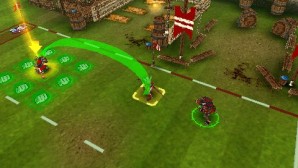 Between both handheld versions, the PSP one is the game that feels that it’s just a shrunken down version of the PC edition, just without the higher crisp graphics. It keeps all of the game modes like Campaign. However there’s no online; multiplayer is strictly hot seat or ad-hoc only. The graphics are still 3D, but feel as if they are just a lower polygon, lower detailed version of their PC counterpart. It’s still not a bad looking game on Sony’s handheld though. If you’re after a handheld version then the PSP version is the way to go, but none of them are as good as the PC version, which feels like it was the focus from the start of development.
Between both handheld versions, the PSP one is the game that feels that it’s just a shrunken down version of the PC edition, just without the higher crisp graphics. It keeps all of the game modes like Campaign. However there’s no online; multiplayer is strictly hot seat or ad-hoc only. The graphics are still 3D, but feel as if they are just a lower polygon, lower detailed version of their PC counterpart. It’s still not a bad looking game on Sony’s handheld though. If you’re after a handheld version then the PSP version is the way to go, but none of them are as good as the PC version, which feels like it was the focus from the start of development.
DS 4/10
PSP 6/10



